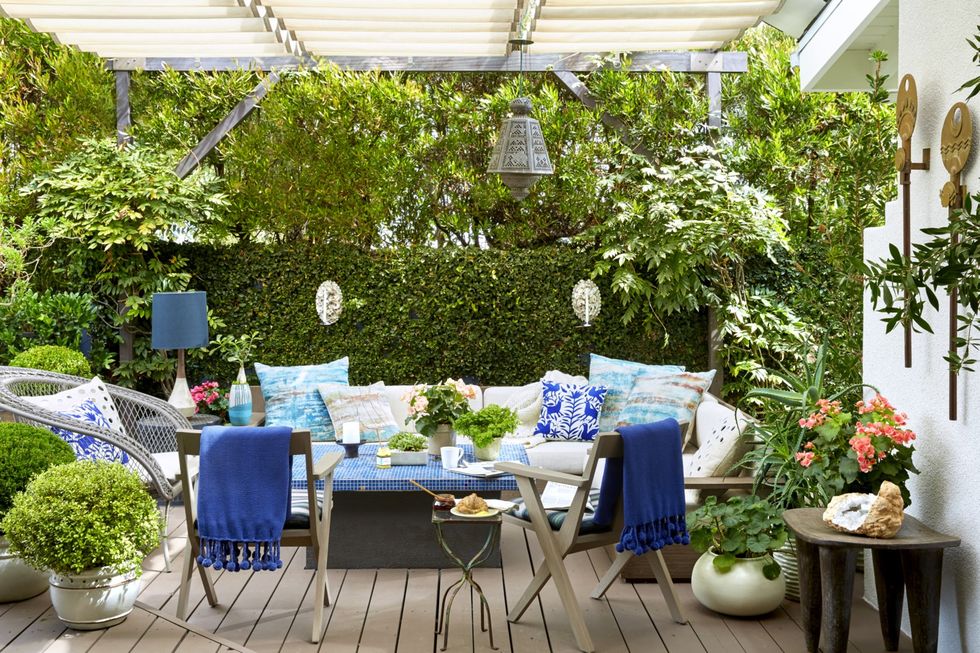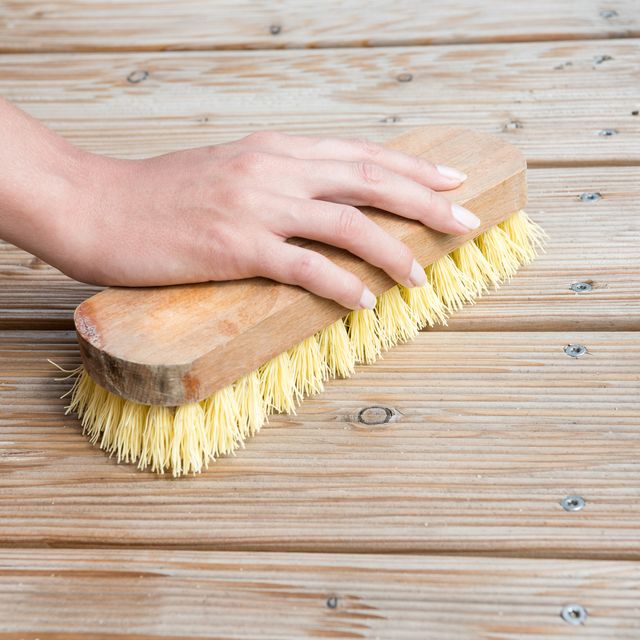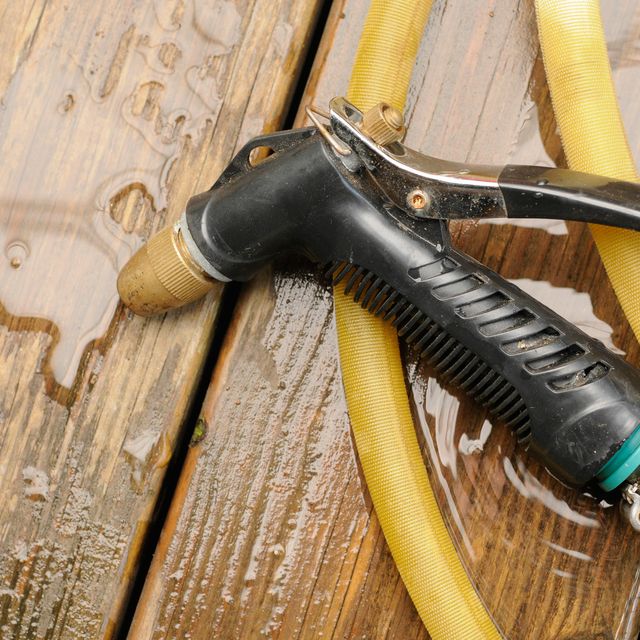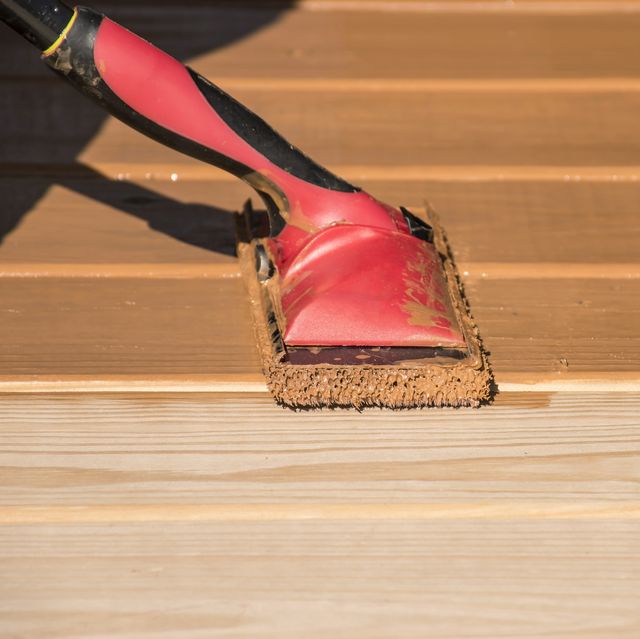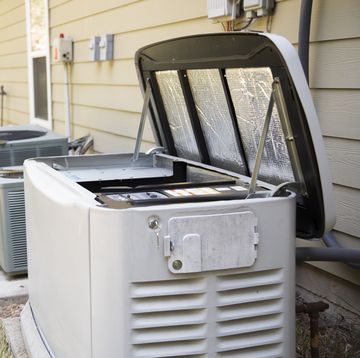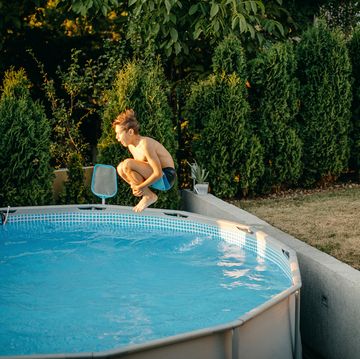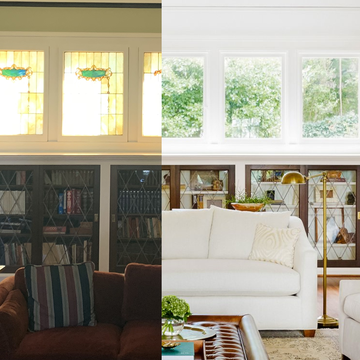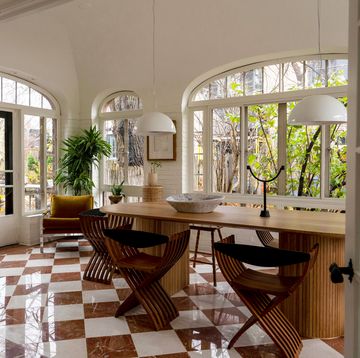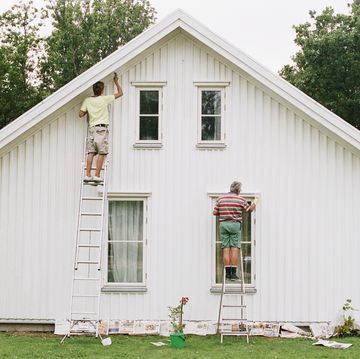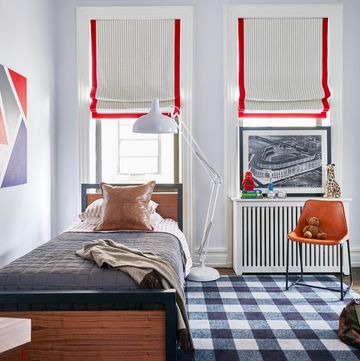Jump to:
With alfresco entertaining season upon us, it's the perfect time of year for any last-minute upgrades to your backyard. Maybe you're thinking about planting some new perennials or replacing your outdoor seating. But to lay a good foundation for a summer of fun, you really should from the ground up by refinishing or staining your deck. If the wood on your backyard patio is looking a little worse for the wear, it's time to give it a makeover.
Staining your deck doesn't just renew the wood's color, it also protects and reconditions it. The varnish strengthens it against the weather and helps prevent peeling, cracks, splinters, and warping. Even if your deck is made of pressure-treated wood, which deters rot or bugs, stain still adds a layer of protection—and it's more durable than paint. You need to stain your deck regularly (every couple years, depending on where you live) to keep the wood in good condition.
Before you head to the hardware store, you'll want to know how to choose the right stain and how to apply it. Not sure where to start? We reached out to Jessica Barrat, an expert with the paint and stain manufacturer Behr, to find out everything you need to know about staining a deck.
How To Choose a Wood Stain Type
Picking a wood stain isn't as complicated as choosing a paint color, but it's close. Deck stains range from essentially colorless to fully opaque, and choosing the right one depends on a number of factors, including the age of the surface you're staining (older decks will naturally be more weathered and gray) and how long you want the new stain to last.
For a newer deck, Barr recommends a transparent stain, which lets you take advantage of the existing wood grain. "You can see through it, but it still has some color," says Barr. If your deck is five to 10 years old, the surface has probably undergone some discoloration, so she suggests stepping up to semi-transparent. "It's still slightly see-through, but there's a lot more color infusion so you'll see less of the wood grain," she says. "There's also a lot more color options than you'd get with a transparent stain." Finally, for an older deck with graying wood, try a solid color stain. "It looks like paint but still allows the texture of the wood to come through," she says.
The more opaque the stain, the better the wood protection and lasting effects. "Using a solid stain is like putting SPF 70 on your skin," says Barr. "If the sun can’t get to the wood, it won’t fade it as much!"
How to Choose a Wood Stain Color
The species of wood you're starting with will affect the final outcome, so you'll want to keep that in mind while picking a color. The most common types of decking are pine and cedar, and on the West Coast, even redwood. "Pine is naturally much lighter, which means it can accept colors more evenly," says Barr. "Cedar has more of a brownish tone, while redwood has that strong red undertone which can look funky with certain stain colors."
Some companies, including Behr, sell sample pots of their stains. Barr recommends taking a few home and trying them in an inconspicuous area of your deck to see how it looks. You can get solid stain color matched to coordinate with the trim of your home.
Do I Need To Stain My Brand-New Deck?
If you have a brand-new deck, you can probably skip the stain, right? Definitely not, says Barr. "Wood's biggest enemy is the sun. If left untreated, those UV rays will beat up the wood pores and turn them gray and other nasty colors," she explains. "Stain provides UV resistance using colorant or silicone while still allowing the wood to expand and contract."
You'll still want to start with a wood cleaner even if you're dealing with a new deck. Even untreated wood has a clear coating, a naturally occurring substance known as mill glaze.
How To Stain a Deck
Check the weather before you get started. As when painting your house's exterior, a warm, dry day with temperatures in mid-70s is ideal for staining a deck. Because you'll be working with chemicals that have fumes, it's important to wear safety gear like gloves.
Supplies
- Acid-resistant gloves
- Safety goggles
- Respirator mask
- Nylon/poly paint brush or roller
- Outdoor scrub broom or brush
- Garden hose with a nozzle
- Wood stain and finish stripper, such as Behr Wood Stain & Finish Stripper
- Wood cleaner, such as Behr Premium All-in-One Wood Cleaner
- Wood stain
- Natural-bristle paint brush
- Paint roller or pad
- Pump paint sprayer (optional)
Step 1: Strip the Surface
Before you pick up a brush, make sure your deck's surface is totally clean, says Barr. "If you don't clean properly, I can't promise that the new stain will actually last as long as it says it will on the outside of the can," she warns.
The first step is to remove any remnants of existing stain, even if the new stain you're planning to use is the same color and transparency as the original. "Think of your deck as a sponge—if the wood is clean, it'll act like a dry sponge and soak up the new stain easily, but if there's any stain already there, the wood is like a wet sponge and nothing else will be able to soak in," says Barr.
For the best results, use a specialized stain and finish stripper. "You typically apply it to the wood, let it sit 15 to 45 minutes, and then take an outdoor scrub brush and give it a little push until the stain starts coming off and tints the cleaner itself," says Barr. Depending on how many coats of stain you're trying to remove, you might have to repeat this step more than once.
Step 2: Clean the Wood
After the old stain is totally removed, you'll want to use a wood cleaner. "Stain stripper only removes the top layer, but the wood cleaner neutralizes the stripper and gets inside the wood pores and digs out the dirt and debris and even mildew," explains Barr.
When rinsing the stripper and cleaner, Barr suggests using a garden hose—and steering clear of pressure washers. "Most people think they can just pressure wash and then apply the stain, but in reality, wood surfaces are very soft and should be treated carefully," she says. "If you use a pressure washer too close or at too high a speed, it can cause splintering, fuzziness, or other damage."
Step 3: Apply the Stain
When it comes to actually applying the stain, follow the directions on the can. You'll want to use a high-quality brush with natural bristles to apply stain; nylon/poly bristle brushes don't work as well with oil-based products like stains. Start on the edges, doing just a few boards at a time, and then a use roller or pad to get the larger areas in between. (You can also use a pump sprayer if you have one, but it's not necessary.) Make sure to go back and forth to get an even application. If you're doing more than one coat, let the stain dry completely in between them.
Step 4: Keep Up the Regular Maintenance
A bit of maintenance can help your deck keep that just-stained look for longer, says Barr. Regularly sweep off any debris, especially fallen leaves (they have tannins that can stain the deck's surface). Clean up spills and other sticky stuff with mild dish soap. And do a more thorough cleaning twice a year, preferably once in the fall and once in the spring.

Emma Bazilian is a writer and editor covering interior design, market trends and culture. She has very strong feelings about tissue box covers and believes that everything is better with toile.
Kate McGregor is House Beautiful’s SEO Editor. She has covered everything from curated decor round-ups and shopping guides, to glimpses into the home lives of inspiring creatives, for publications such as ELLE Decor, Domino, and Architectural Digest’s Clever.

